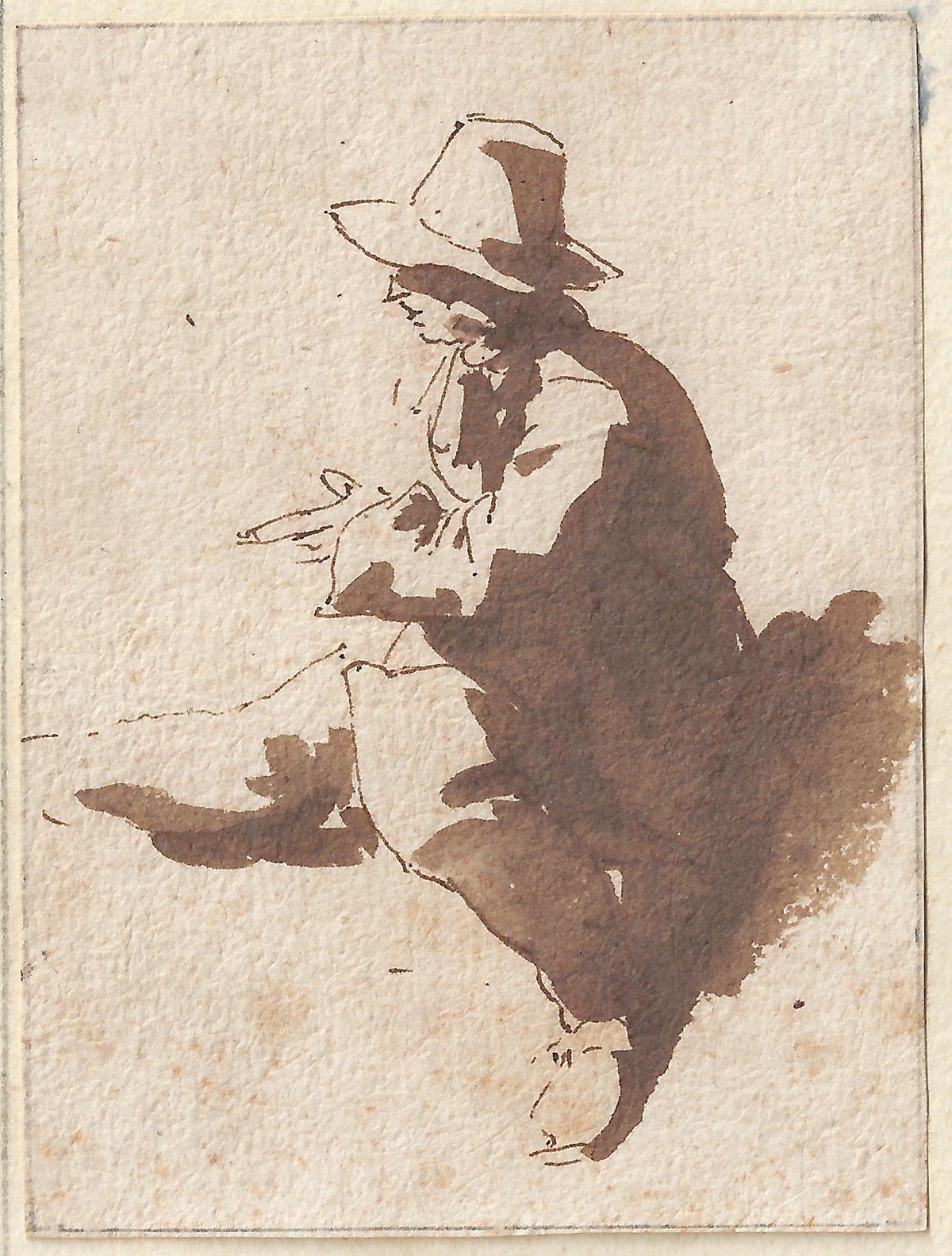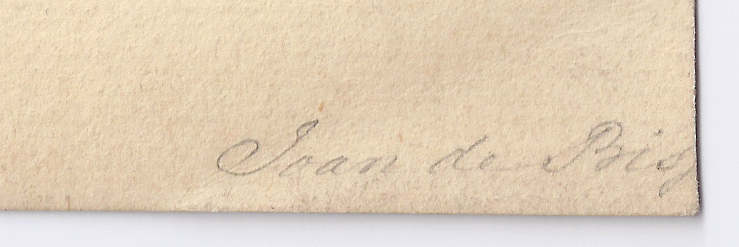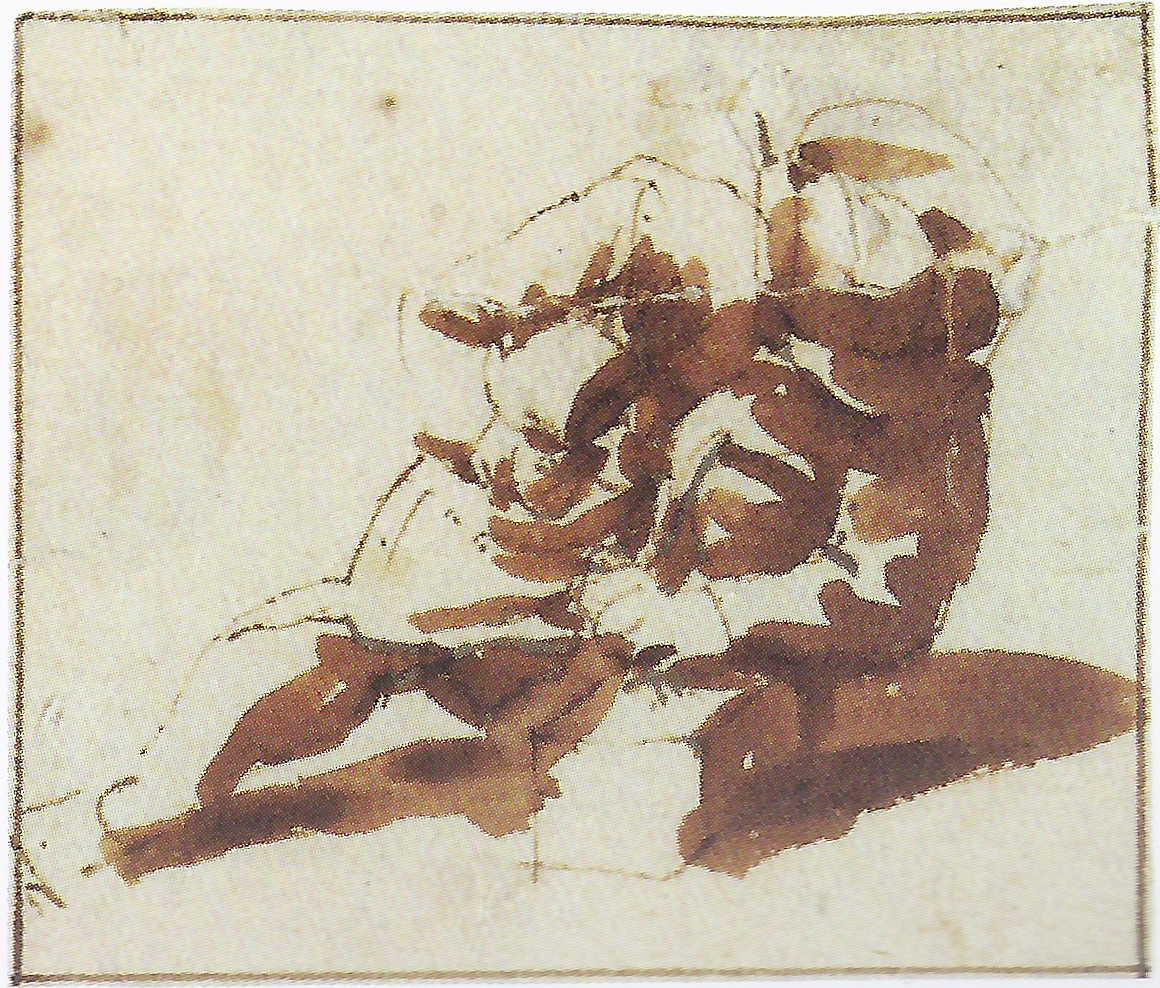JAN DE BISSCHOP (Amsterdam 1628 – 1671 The Hague)
Jan de Bisschop (Amsterdam 1628 – 1671 The Hague)
Study of a Seated Man
Pen and brown ink, brown wash, graphite framing lines, 78 x 58 mm (3.1 x 2.3 inch)
Tipped onto a partial early collector’s sheet with framing lines in graphite, and a partial inscription ‘Joan de Biss[chop]’ (in an 18th-century hand)
Provenance
Private collection, Belgium
***
Despite being an amateur, Jan de Bisschop, also known as Johannes Episcopius, was widely influential in art and art publishing.1 A lawyer by profession, he set up practice in The Hague around 1652 and later founded a drawing academy there, the Confrerie Pictura. He mingled with an elite circle of intellectuals that included his friend and fellow amateur draftsman Constantijn Huygens the Younger.
Bartholomeus Breenbergh, who lived in De Bisschop’s native Amsterdam for a time, most influenced De Bisschop’s draftsmanship. His landscapes in brown ink wash imitated Breenbergh’s evocations of Italianate views flooded with sunlight. Despite drawing numerous Italianate landscapes, De Bisschop probably never went to Italy; other artists’ works were his sources. Whether drawing with pen or brush, De Bisschop used a warm golden-brown ink, later named ‘Bisschops-inkt’ after him.
In addition to landscapes, De Bisschop made figure studies and drawings after Classical sculptures and famous paintings, primarily by Italian artists. His published collections of engravings, the Signorum Veterum Icones of 1668-69, which reproduced antique sculptures, and the Paradigmata Graphices variorum Artificum of 1671, after drawings of Italian artists of the Renaissance, were instrumental in disseminating the Classical style in The Netherlands.2 He also designed title pages for books, mostly by Classical authors, and published his own compositions. De Bisschop’s own collection of ‘papierconst’, comprising drawings and prints, was sold in The Hague on 22 March 1672, and his studio inventory was sold on 10 February 1677. Unfortunately catalogues of both sales have not survived.
De Bisschop’s original drawings (rather than copies after Classical sculptures and Italian paintings and drawings) are frequently of small to miniature size, as is the present intimately beautiful drawing. They were originally almost certainly part of small-size sketch albums which the artist could easily carry around wherever he went, to document fleeting impressions and interesting views. De Bisschop was a highly accomplished draftsman, who was able to record a scene in a matter of minutes. The broad application of wash in this sheet is especially successful, and conveys the sense of strong sunlight on a summer’s day to perfection. Our drawing can for instance be compared to a study of a stonemason by De Bisschop, preserved in an eighteenth-century album of drawings, now in the Victoria & Albert Museum, London (fig.).3
From the letters of Constantijn and Christiaan Huygens it is known that De Bisschop founded a private drawing academy around 1661. A frequent model was a man called Anthonij, also known under the tantalising alias of ‘de vliegende Platluys’ (‘the flying pubic louse’). A sheet with five studies of what is probably this model is preserved in the Prentenkabinet der Rijksuniversiteit, Leiden (fig.).4 Our drawing is especially comparable to the study at the lower left in the Leiden sheet, and it is likely that the model Anthonij is depicted again here. If the drawing was made during a session in the academy, the strong sense of light and shadow could have been produced by artificial lighting.
SOLD
1. For the artist, see Renske E. Jellema and Michiel C. Plomp, Episcopius: Jan de Bisschop (1628-1671), lawyer and draughtsman, Amsterdam 1992 and J.G. van Gelder, Jan de Bisschop, The Hague 1971.
2. See J.G. van Gelder and Ingrid Jost, Jan de Bisschop and the Icones & Paradigmata: Classical antiquities and Italian drawings for instruction in seventeenth century Holland, Doornspijk 1985.
3. Pen and brown ink, brown wash, 50 x 59 mm; inv. D.1212:133-1889; see Jane Shoaf Turner and Christopher White, Dutch & Flemish Drawings in the Victoria & Albert Museum, London 2014, vol. I, p. 65, no. 23.132, repr. The album includes many drawings by De Bisschop. It was previously owned by Cornelis Ploos van Amstel (1726-1798) and Horace Walpole (1717-1797).
4. Pen and brown ink, brown wash, 105 x 79 mm; Jellema and Plomp, op. cit., p. 64, no. 60, repr.




